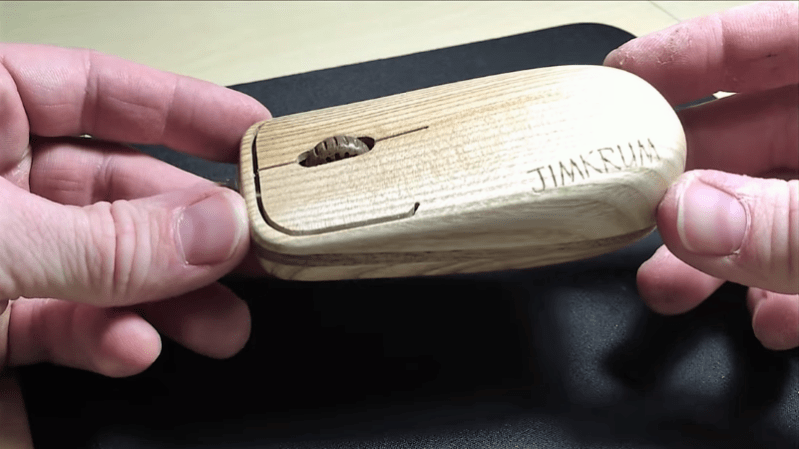First off, we’ll admit that there no real practical reason for wanting a wooden mouse – unless of course the cellulose rodent in question is the one that kicked it all off in “The Mother of All Demos” fifty years ago. Simply putting a shell around the guts of a standard wireless optical mouse is just flexing, but we’re OK with that.
That said, [Jim Krum]’s design shows some impressive skills, both in the design of the mouse and the build quality of his machine. Starting with what looks like a block of white oak, [Jim] hogs out the rough shape of the upper shell and then refines it with a small ball-end mill before flipping it over to carve the other side. His registration seems spot on, because everything matches up well and the shell comes out to be only a few millimeters thick. The bottom plate gets the same treatment to create the complex shape needed to support the mouse guts and a battery holder. He even milled a little battery compartment cover. He used a contrasting dark wood for the scroll wheel and a decorative band to hold the top and bottom together and finished it with a light coat of sealer.
It’s a great look, and functional too as the video below reveals. We’ve seen a few other fancy mice before, like this wood and aluminum model or even one that would look at home on [Charles Babbage]’s desk.
Thanks to [Itay Ramot] for the tip.















Nice work!
The cheap bamboo mice tend to break off the buttons after a week. It would be better if they were separate pieces and hinged. It is cool that custom mice are becoming popular. /u/Ukrainian_Optimus (americas tallest man) is looking for one I understand.
Igor?
He lives in Rochester, MN, not far from me.
Indeed, thats him. Here’s one of the threads, theres a few more with even more comments in his history. https://www.reddit.com/r/3Dprinting/comments/9whquu/any_3d_printing_experts_in_minnesota_willing_to/
Toymakers (makerspace) in Rochester might need to be alerted to this.
Thanks!
Come on hackaday, why not take up this challenge and help Igor out? While fixing mice, go meet him, do some video, discuss other things that are a pain for him (I imagine some taps suck, toilet flush handles, other things designed for small hands) and see if we can’t help him?
I once handed him a can of Seven-Up,
in proportion, it was the size of salt shaker in my own.
There is clearly a gap in the market for mice for humans with large hands. I’ve been looking for years for one, but I found that is was easy to find mice for small hands, and impossible to find larger ones. I have since given up on my search, but I have since purchased a 3D printer, so I could try to fabricate one for myself, or could go the complicated route, the Hackaday preferred route, where I 3D print all the parts I need to make a MPCNC (Mostly Printed CNC) and then make a mouse out of wood.
I bet it feels amazing.
> we’ll admit that there no real practical reason for wanting a wooden mouse
WE will admit that ANY material that gives a better haptic comfort than standard plaste is reason enough to want it. For someone who works up to 18 hours a day with various computer input devices, haptics are a key feature and there aren’t many “mouses” (I don’t like to call input devices “mice”) available that aren’t causing issues after extended use.
Wood sounds like one good idea.
Yeah, wood also works great with sweaty hands, unlike plastic / rubber. Another reason could be being sensitive to plasticizers.
Think your last two links might be swapped there. Cool build!
D’oh! Fixed it. Thanks for the heads up.
‘No practical reason’? As someone who knows that models can easily be scaled up and is able to pick up a basketball with one hand, I can think of at least one.
We waiting for keyboard, with open source electronic
chose open platform and cut ;)
GH60
D’oh, should’ve given it PTFE/UHMW-PE pads to reduce friction, like all commercially available mice have.
Never worked with wood, did you? It can be as smooth as you like and some even are self lubricating. But then again, I wouldn’t stop you build your own with those pads, comfy chair engineer…
that downward slope cut with a ball nose end-mill is a bit cringy. Am I missing some use case where this is considered a best practice? I was always told to try and use as close to the diameter of the cutter as possible. The end result is really nice and i wouldn’t doubt that there is less worry about cut direction and possible issue when working with wood. That being said it seems as if it is common among cnc router users to miss out on some of the basics like taking deeper cuts with less step-over (utilizing more of the cutter length) or trying to stay away from using the center of the cutter (the part that has a lower surface cutting speed)